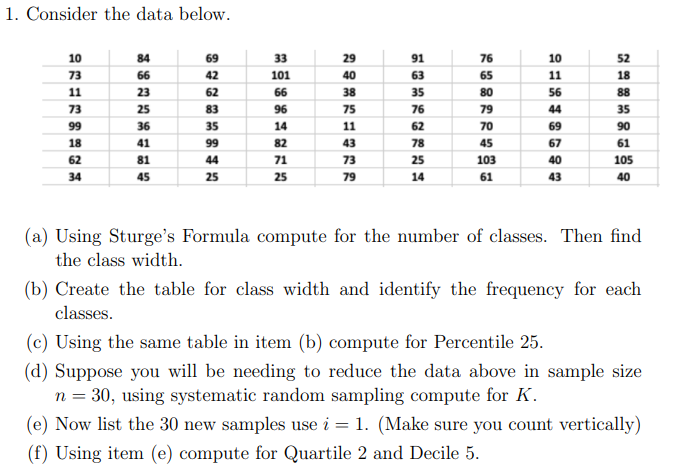1. Consider the data below. 10 84 69 33 29 91 76 10 52 73 66 42 101 40 63 65 11 18 11 23 62 66 38 35 80 56 88 73 25 83 96 75 76 79 44 35 99 36 35 14 11 62 70 69 90 18 41 99 82 43 78 45 67 61 62 81 44 71 73 25 103 40 105 34 45 25 25 79 14 61 43 40 (a) Using Sturge's Formula compute for the number of classes. Then find the class width. (b) Create the table for class width and identify the frequency for each
1. Consider the data below. 10 84 69 33 29 91 76 10 52 73 66 42 101 40 63 65 11 18 11 23 62 66 38 35 80 56 88 73 25 83 96 75 76 79 44 35 99 36 35 14 11 62 70 69 90 18 41 99 82 43 78 45 67 61 62 81 44 71 73 25 103 40 105 34 45 25 25 79 14 61 43 40 (a) Using Sturge's Formula compute for the number of classes. Then find the class width. (b) Create the table for class width and identify the frequency for each
Holt Mcdougal Larson Pre-algebra: Student Edition 2012
1st Edition
ISBN:9780547587776
Author:HOLT MCDOUGAL
Publisher:HOLT MCDOUGAL
Chapter11: Data Analysis And Probability
Section11.4: Collecting Data
Problem 2E
Related questions
Question
Provide answer for the sub-part d,e,f

Transcribed Image Text:1. Consider the data below.
10
84
69
33
29
91
76
10
52
73
66
42
101
40
63
65
11
18
11
23
62
66
38
35
80
56
88
73
25
83
96
75
76
79
44
35
99
36
35
14
11
62
70
69
90
18
41
99
82
43
78
45
67
61
62
81
44
71
73
25
103
40
105
34
45
25
25
79
14
61
43
40
(a) Using Sturge's Formula compute for the number of classes. Then find
the class width.
(b) Create the table for class width and identify the frequency for each
classes.
(c) Using the same table in item (b) compute for Percentile 25.
(d) Suppose you will be needing to reduce the data above in sample size
n = 30, using systematic random sampling compute for K.
(e) Now list the 30 new samples use i = 1. (Make sure you count vertically)
(f) Using item (e) compute for Quartile 2 and Decile 5.
Expert Solution
This question has been solved!
Explore an expertly crafted, step-by-step solution for a thorough understanding of key concepts.
Step by step
Solved in 3 steps with 3 images

Recommended textbooks for you

Holt Mcdougal Larson Pre-algebra: Student Edition…
Algebra
ISBN:
9780547587776
Author:
HOLT MCDOUGAL
Publisher:
HOLT MCDOUGAL

Holt Mcdougal Larson Pre-algebra: Student Edition…
Algebra
ISBN:
9780547587776
Author:
HOLT MCDOUGAL
Publisher:
HOLT MCDOUGAL